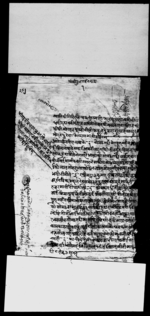A copy of a lālamohara from King Pṛthvī Vīra Vikrama authorizing Hīrānātha to serve as abbot of Rānāgāũ monastery (VS 1944)
ID: K_0469_0024
Edited and
translated by Christof Zotter
Created: 2018-05-18;
Last modified: 2023-02-13
For the metadata of the document, click here
The accompanying edition, translation/synopsis and/or commentary are available under the terms of the Creative Commons Attribution-ShareAlike 4.0 International License
Abstract
In the lālamohara of which this is a copy, King Pṛthvī confirms Mahanta Hīrānātha as successor of Mahanta Gosāī̃ Khīmānātha on the throne (gaddī) of Siddha Bhagavantanātha's monastery (maṭha) in Rānāgāũ, Salyan.Diplomatic edition
[1r]
⟪125⟫1श्रीसीद्धभगवंतनाथ2१⟪1लालमोहर•⟫⟪1रुजुदुरुस्तछ
2स्हीडीट्टाद्योतीप्रसाद⟫1श्रीमद्दतीप्रचण्डभुजदण्डेत्त्यादीश्री
2श्रीश्रीमाहाराजवीरसम्सेरजङ्गरा
3णावाहादुर•प्राईमीनीष्टर•य़ाण्डक
4म्यांडरइनचीफ्¯¯¯¯¯¯¯[seal of Lokanātha]1सकलवुझीसकलवमोजीमनकलदुरुस्तछभनीसहीछापग
2र्नेमहंतछेत्रनाथजीकाचेलालोकनाथजी¯¯1स्वस्तिश्रीगिरिराज•चक्रचूडामणी•नरनाराये़णेत्यादीवीवी
2धवीरूदावलीवीराज•मानमानोन्नत्श्रीमन्माहाराजाधिराजश्री
3श्रीश्री•महाराजपृथ्वीवीरवीक्रम्जङ्गवाहादुरसाह•वहादुरस
4म्सेरजङ्गदेवानांसदासमरवीजय़ीनाम¯¯¯¯¯¯¯¯¯
5आगेमहंतहिरानाथके¯ १ ¯कोमठगद्दी•मेरागुरुमहंत•गोसा
6ईषिमानाथलेमलाईअषतीय़ारगरीदीनीजगुरुषिमानाथप
7रलोक•हुंदामैलेभोगगरीआय़ाकोसोमठगद्दी•सर्कारवाट[...]
8नीमलाईथामीवक्सीसनदभैसकीय़ाकोछमेरानाउंमामहंत्[...]
9ईकोलालमोहोरभय़ाकोछैनलालमोहोरगरीवक्स्याहुदोहो
10भनीतीमीले¯ २ ¯रश्रीमद्रा•जकुमार•कुमारात्मजश्रीक[...]
11डरईनचिफजनरलदेवसम्सेरजङ्गराणावहादुरमार्फत[...]
12हजुरमावींतीपार्दासो¯१¯कोमठगद्दीतीम्रागुरुमहंत[...]
13साईषिमानाथलेतीमीलाई•अषतीय़ारगरीदीनीजतीम्रा
14गुरु•महंतषिमानाथपरलोगहुदातीमीले•गरीआय़ा
15को•सोमठहाम्रावर्ष१३काऊमेरहुदाहामीवाटपनी४४[...]
16लदेषी•तीमीलाईअषतीय़ारगरीथामीवक्स्यौंआफ्ना •षा[...]
17रज्मासीतसोमठगद्दीमाअघिदेषिदरिचलीआय़ावमोजी[...]
18कामकाजगरीआफुलाईदरीय़ाकाजगाकोदामकामअ[...]
19तहसील•गरीअघिदेषि•चलीआयावमोजीम्•कतीघटी[...]
20नपारी¯ १ ¯कानीत्येनैमीत्ये•कपुजा भंडाराचलाई•हा[...]
21जयेमनाईभोगेगर•ईतीसम्वत्१९४४सालमीतीमाघ[...]
22दी८रोज७शुभ्म्¯¯¯¯¯¯¯¯¯¯¯¯¯¯¯¯¯¯¯¯
Translation
[1r]
251
Venerable SiddhaBhagavantanātha -1-2
[The copy] is attested as correct; signature: ḍiṭṭhā (?) Dyotīprasāda3
[in the left margin:]
The thrice venerable great king, who is illustrious, very mighty and has arms like a staff etc., prime minister and commander-in-chief, Vīra Śamśera Jaṅga Rāṇā Bāhādura
Having received the original [and] attesting that the copy is true to the original, Lokanāthajī, the disciple of MahantaChetranāthajī4
[main text:]
Hail! [A decree] of him who is shining with manifold rows of eulogy [such as] "The venerable crest-jewel of the multitude of mountain kings" and Naranārāyaṇa (an epithet of Kṛṣṇa) etc., high in honour, the venerable supreme king of great kings, the thrice venerable great king, Pṛthvī Vīra Vikrama Jaṅga Bahādura Śāha, the brave swordsman, the divine king always triumphant in war
As you have submitted a petition to us through [Prime Minister and Commander-in-Chief Vīra Śamśera Jaṅga Rāṇā Bāhādura (...)]6 and the venerable prince born of a prince, Commander-in-Chief General Deva Śamśera Jaṅga Rāṇā Bahādura, saying: "My guru Mahanta Gosāī̃Khīmānātha7 gave me authority [over] the throne of the monastery of [Venerable Siddha Bhagavantanātha],8 the same guru Khimānātha (later) passed away,9 [and] I have (ever since) been exercising [that authority]. A sanada granting me the throne of this monastery has already been issued by the government (sarkāra).10 A lālamohara [in bestowal] of the abbotship (mahantyāīko) has not been [issued yet] in my name. If you granted a lālamohara [that] would be [good for me]." We, for our part, being in our 13th year,11 confirm from the year [VS 19]44 onward your authority [over] this monastery, [which] you have been exercising (ever since) your guru, Mahanta Khīmānātha, passed away,12 the same guru of yours, Mahanta Gosāī̃ Khīmānātha, having given you authority [over] the throne of the monastery of [Venerable Siddha Bhagavantanātha].
Enjoy [what is given to you], doing work duteously according to the customs that have been practised before, collecting the income due (dāmakāma) on the land registered in your name, as practised before, without any decrease or increase, conducting the daily and occasional pūjās and feasts of the throne of the monastery of [Venerable Siddha Bhagavantanātha], and celebrating our victories.13
Saturday, the 8th of the dark fortnight of Māgha of the [Vikrama] era year 1944 (1888 CE).14 Auspiciousness.
Commentary
The copy edited here does not record the signatures on the backside of the original document.15 According to the edition of the document produced by Yogī Naraharinātha the lālamohara was channelled through (mārphata) an unusal large number of high-ranking officials,16 namely GururājaDharmādhikāraDujarāja Paṃḍītajyū, venerable Commanding-General of the Northern Front Lalīta Śamśera Jaṅga Rāṇā Bahādura, venerable GurupurohitaAmvararāja Paṃḍītajyu, venerable Gurupurohita KhajāncīVāmadeva Paṃḍīta, KājīLakṣmībhakta Upādhyā, CautarīyāRaṇasera Sāha, Commander Colonel Kula Vīkrama Dhoja Rāṇā, venerable Commanding-General of the Eastern Front Bhīma Śamśera Jaṅga Rāṇā Bahādura, thrice venerable Mahārāja Vīra Śamśera Jaṅga Rāṇā Bahādura, Prime Minister and Commander-in-Chief, venerable [Commander-in-Chief General]17 Deva Śamśera Jaṅga Rāṇā Bahādura, venerable [Senior Commanding-General of the Western Front]18 Candra Śamśera Jaṅga Rāṇā Bahādura (Naraharinātha VS 2022: 465f.).
Hīrānātha was seemingly the last mahanta of the maṭha in Rānāgāũ who received such a mahantyāīko lālamohara from Kathmandu as confirmation of his abbotship. After he passed away (probably in VS 1963),19 his successor Chatranātha, the son of Hīrānātha's guru Khīmānātha, petitioned to get a lālamohara in his name, but died without having succeeded in VS 1964 (see K_0468_0061), while Hīrānātha's son Lokanātha, who was selected by Chatranātha as his successor, had to face a struggle with Chatranātha's elder brother Devinātha, who claimed the gaddī for himself (ibid.). According to the Yogīvaṃśāvalī, Lokanātha left Nepal frustrated, never to return (Naraharinātha n.d.: 89; see also Bouillier 1991: 168 and the Commentaries to K_0469_0033 and K_0469_0015).

